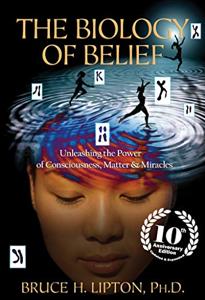
Want to learn the ideas in The Biology Of Belief better than ever? Read the world’s #1 book summary of The Biology Of Belief by Bruce H. Lipton Ph.D. here.
Read a brief 1-Page Summary or watch video summaries curated by our expert team. Note: this book guide is not affiliated with or endorsed by the publisher or author, and we always encourage you to purchase and read the full book.
Video Summaries of The Biology Of Belief
We’ve scoured the Internet for the very best videos on The Biology Of Belief, from high-quality videos summaries to interviews or commentary by Bruce H. Lipton Ph.D.
1-Page Summary of The Biology Of Belief
Overview
When you are stressed, your immune system will not function properly. Therefore, you should meditate when you are in a stressful situation. Meditating also helps reduce negative subconscious thoughts that can affect your health.
Recent research in biology shows that genes have been overestimated for a long time and that the environment and our perceptions are more influential than previously thought. The Biology of Belief explains how this new understanding can be applied to practical conclusions about life, including spirituality.
In this passage, you will learn about three key points. First, we will discuss what switches our genes on and off. Next, we will talk about why it’s important to make peace instead of war. Finally, we will discuss how humans are made in the image of God/the universe.
Big Idea #1: In the theory of evolution, cooperation is more important than competition.
Jean-Baptiste Lamarck was the first person to discover evolution. Charles Darwin is famous for discovering it, but he’s not the first one who actually discovered it.
Lamarck’s theory of evolution is similar to Darwin’s, but they’re not the same.
Unlike Darwin, Lamarck believed that evolution wasn’t a fight for survival. Instead, it was more of a cooperative effort between species and individuals.
Unlike Darwin’s theory of evolution, Lamarck believed that species evolved by learning to adapt to their surroundings.
Lamarck’s view is more similar to our current understanding of evolution.
For example, we can see how the immune system adapts to changes in the environment and passes this knowledge on to offspring.
When a virus enters our body, the antibodies fight it. If they are successful in killing the virus, they remember how to kill that particular type of virus and pass on their memory to daughter cells.
Lamarck’s theory that animals often work together can also be demonstrated by modern scientific research. This is not just limited to species of the same kind, but different kinds as well. There are many examples in nature where symbiotic relationships occur between species.
For example, our digestive system contains billions of bacteria to help it digest the food we eat.
Furthermore, even the genes of animals are affected by cooperation between species.
Science has revealed that genes don’t have to be passed on through reproduction from individual to individual, but they can be shared with members of other species.
“The only thing that interferes with my learning is my education.” – Albert Einstein
The following information shows how our knowledge of the biology of human cells confirms Lamarck’s theory.
Like this summary? Want to learn more from books than ever? You'll love my product Shortform.
Shortform has the world’s best guides to 1000+ nonfiction books and articles. Even better, it helps you remember what you read, so you can make your life better. What's special about Shortform:
- The world's highest quality book guides - we discuss the book's main ideas, with expert analysis and commentary expanding will beyond the book
- Interactive exercises that teach you to apply what you've learned
- Discussion communities - get the best advice from other readers
Sound like what you've been looking for? Sign up for a 5-day free trial here.
Big Idea #2: The membrane of a cell controls its behavior.
Lamarck’s theory is important because it emphasizes the importance of cooperation in biology. To illustrate, we can look at nature’s most successful organism – the cell – whose functions are a result of many elements working together.
There isn’t a single function in our bodies that doesn’t exist in a single cell.
Cells are very intelligent. They were among the first life forms on our planet and have survived while most creatures died out.
When cells are removed from the body and placed in a culture, they will actively seek out environments where they can survive.
But what are the factors that contribute to this intelligence and how do cells behave?
Most people would probably guess that a cell’s nucleus is where chromosomes are stored. However, if this were true, the cell should die as soon as its nucleus was removed.
Yet it’s been proven that when the nucleus of a cell is removed, the cell will continue to live and function as if it had a brain. This is because reproduction takes place in the nucleus, not its brain.






